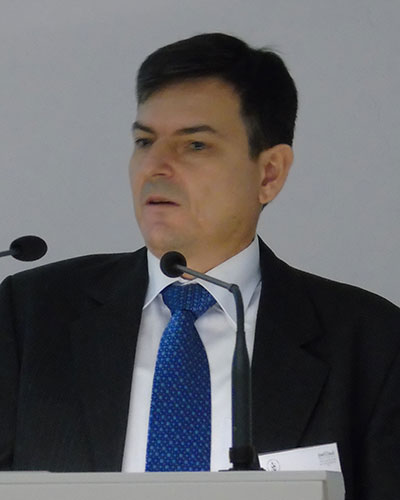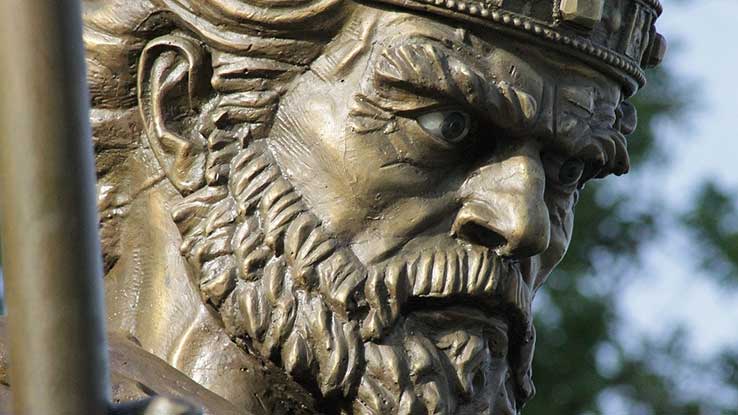Naum Kajchev
 The European idea is based on overcoming the contradictions of the past, on emphasizing things that are common and unifying. No one today has exclusivity over the state of Prince Boris the Baptizer and St. Clement of Ohrid; of Tsar Simeon and St. Naum of Ohrid; of Tsar Samuil and John of Debar and their traditions that are partly preserved by the Byzantine emperor Basil II.
The European idea is based on overcoming the contradictions of the past, on emphasizing things that are common and unifying. No one today has exclusivity over the state of Prince Boris the Baptizer and St. Clement of Ohrid; of Tsar Simeon and St. Naum of Ohrid; of Tsar Samuil and John of Debar and their traditions that are partly preserved by the Byzantine emperor Basil II.
In their article “Uniting around ‘historical truths’ or around differences?”, the members of the Joint Commission for Historical and Educational Issues from the Republic of North Macedonia, Ognen Vangelov and Ljupcho Risteski, are trying to give some answers to my previously published text on “On unifying around our common history – Tsar Samoil erga omnes".
In that first text I provided a number of examples that, in addition to the sources, the contemporary authoritative Byzantine studies in Britain and the United States, as well as in the Balkans – Croatia, Serbia, Albania, Kosovo, including Albanian historians from North Macedonia, consider the state of Tsar Samuil in a similar way: as a Bulgarian Empire. I also mentioned how many times we asked our colleagues from Skopje to quote at least one source that proves that Samuil is some kind of non-Bulgarian "Slavic" or "Macedonian" tzar, but there was no answer. О. Vangelov and L. Risteski had the opportunity to respond publicly in their text, as well as at the 13th meeting of the Joint Historical Commission, which we had on 22 and 23 April 2021. Again, they did not do that. This is not surprising, since there are no known historical sources to support their two theses.
On the Bulgarian ethnicity during the times of Samuil
The two co-authors are rather resorting to another method – they discuss about a non-existent thesis in my text on the "ten-century ethnic homogeneity" of the Bulgarians in Macedonia. In our discussions in the Commission, we pointed out a lot of evidence that the medieval Slavic Bulgarian people was actually created and developed after the ninth-tenth centuries on the territories of the Bulgarian Empire, including much of today's geographical territory of Macedonia (although we never mentioned "homogenization that lasted for ten centuries"), but this is not the topic of my article. Here, I will limit myself to giving a brief explanation and assume that the colleagues medievalists will provide more detailed information on this topic, should that be required.
The two co-authors are not historians – one is a political scientist and the other is an anthropologist. This can be seen from the blog they published. For example, they call “sources” (historical evidence written or derived from the specific era in question, in this case from X to XII century) the books that prof. Momchil Metodiev gave to the members of the Commission, but in fact they are secondary historical works (later, in this case, contemporary studies that use and analyze the sources; without sources, the historical research and the science of history could not exist), such as the monographs mentioned in the first text by Paul Stevenson, Catherine Holmes, Anthony Kalldelis, and others. They confidently state: "None of the bibliographic items included in Mr. Metodiev’s list does not have such categorical claims, nor do those sources deal with such issues. It is exactly the fact that these sources do NOT deal with issues of "permanent ethnic homogenization" of the Bulgarian people on the territory of today's Bulgaria and Macedonia that is the core of disagreement between the Macedonian and Bulgarian part of the Commission.”
It is sufficient to open "The Cambridge History of the Byzantine Empire" provided to us by prof. Metodiev and we will see that, on the contrary, the existence of the medieval Slavic Bulgarian ethnicity in vast geographical areas of the Balkans is generally accepted by the international Byzantine studies – the term "Bulgarians" is used dozens of times, for example to clarify that the Byzantines, in the first third of the tenth century considered the Bulgarians as Barbarians (p.508). We find the same ethnonym in the analysis of the situation of the ruler that is the subject of our interest, such as in the following paragraph: “Samuil could hope to gain through such imperial measures [the reallocation of the relics of St. Achilleus from Larissa to Prespa] acceptance and even allegiance, from his motley assemblage of subjects: Bulgarians, Vlachs, Albanians, Armenians and Greeks” (p. 526).
Here I will remind of something that is well known to the professional historians, but not very familiar to the general public. The term "Macedonians" is used only six times in the Cambridge History, because, in the Middle Ages, in the Balkans, it was basically referring to the representatives of the Byzantine Macedonian dynasty (867-1056) and the inhabitants of the Byzantine theme (province) of Macedonia, which was their place of origin. This theme was located in present-day Thrace, around Edirne and west of it. The majority of these Macedonians, that is, the population of the Macedonia theme, ethnopolitically was Byzantine (‘Roman’) and spoke Greek language.
George Ostrogorsky and his AVNOJ Yugoslavian compromise with Tzar Samuil
Instead of citing a relevant source or a contemporary authoritative study, the two co-authors refer to G. Ostrogorsky (1902-1976) to argue their thesis that "the situation with sources is such that it does not allow final and firm conclusions" about the medieval ruler. He is the only historian quoted by them on the question of Samuil, and this requires brief explanations.
 Source: pixabay.com
Source: pixabay.com
G. Ostrogorski was of White Russian emigrant origin and was a German student, but as a young scholar he moved to Yugoslavia in 1933 and remained there until the end of his life in 1976. He was well received, both in royal and later in AVNOJ Yugoslavia of Tito. He became a professor of Byzantine history at the University of Belgrade and a lifelong director of the Byzantine Institute at SANU, which he founded himself. Regardless of the origin and the undoubted scholar qualities, prof. Ostrogorski was a head of the Yugoslav Byzantine studies, which influenced his treatment of the state of Tsar Samoil, which was a peripheral topic in itself in his research. However, in the first German edition of his "History of the Byzantine State" in 1940, he explained that "in terms of state and church, it (the Empire of Samuil) was united with the empire of Simeon and Petar; it was regarded simply as a Bulgarian empire both by its creators and by the Byzantines...” (p.213). This correct explanation was preserved in subsequent editions, regardless of the conjuncture.
The two co-authors cite the Russian version, which is a translation of the third German edition from 1962, written at a time when Josip Broz Tito, Aleksandar Ranković and Lazar Kolishevski were politically dominant. G. Ostrogorski again revised his first edition and "supplemented" it with a new claim – that it was a "Macedonian state", which differed from the previous Bulgarian one (p.378). To summarize: turning to Yugoslav historiography on Macedonia from 1950s and 1960s is a journey into the past that could lead to severe conflicts not only with the sources, but with the entire world historiography.
It is also necessary to specify that the list provided by prof. Metodiev intentionally includes only foreign authors whose research has been published by authoritative English-language publishers in the last 30 years. The reason for this was the thesis put forward by some colleagues from the Republic of North Macedonia about the "outdated" and even "primordial" approach of the Bulgarian historians to the topic of the state of Tsar Samuil. For that reason, the list intentionally omits to include Bulgarian authors and foreign authors who worked in the time of George Ostrogorsky or before him. It is particularly impressive that the contemporary literature does not even raise the idea of Samuil as a non-Bulgarian "Slavic" or "Macedonian" emperor, which is an indication of the exotics of this hypothesis, although from the discussions on the ethnic composition of the state it can be seen that it is familiar to the authors.
Are there enough sources about Samuil?
Both co-authors deem that there are no enough sources about the state of Samuil, and they attribute that to "almost everyone" of the books offered by prof. Metodiev. In fact, none of these titles refers specifically to Tsar Samuil. Some Byzantine scholars, such as Anthony Kaldellis, in his cited book Romanland: Ethnicity and Empire in Byzantium, write the opposite – "the problem of ethnicity is abundantly attested in the primary sources but rarely discussed in scholarship on Byzantium" (p.XI). Other scholars, such as Catherine Holmes, note that the problem of the fragmented base of sources on Byzantium is typical for the entire history of the early medieval Europe (p.7).
Like all historians, we would also like to have more sources. Yet there are still enough well-preserved primary sources about Samuil and his Empire. Without going into details, we will mention only a few of them – The Bitola inscription of Tsar John Vladislav from 1015, exhibited in the museum in Bitola, in which the nephew of Samuil defined himself as "Bulgarian sovereign" and "Bulgarian by birth", who restored the fortress in Bitola "for the refuge and for salvation, and for the life of the Bulgarians". His contemporary, the Arab Christian historian Yahya of Antioch, described in detail the war of the Byzantine emperor Basil II with the Comitopoulos-led state: "Emperor Basil faced the Bulgarians and forced them to flee. He captured their king and sent him back to the dungeon from which he escaped. The Comitopoulos, who is the commander of his army, escaped and ruled the Bulgarian Empire". Emperor Basil II himself, in his Charter of about 1019, gladly testified that "the Roman state has expanded and the Bulgarian state has entered under yoke in it". There are many similar testimonies. Most of them were collected in a separate volume by the late prof. В.Tăpkova-Zaimova, which was recently translated into English.
The historians define the features of Samuil’s state not only on the basis of its name. As our colleague Georgi Nikolov, author of books about Samuil and president of the Macedonian Scientific Institute, pointed out, the Byzantine sources testify about the "Kavhans" Dometian and Theodore under the son of Samuil, Tsar Gavril Radomir, and such a title and position in the Balkans existed only in the first Bulgarian medieval state.
In that regard, if, according to O.Vangelov and L.Risteski, the Bulgarian character of the state of Tsar Samuil and his successors is "ready-made theses, which to a greater or lesser extent are controversial", then, due to the existence of many preserved evidences, this is a generally accepted dominant position of the whole world medieval studies today.
On the precise use of the definitions from the methodology of teaching history
The two co-authors continue to emphasize the "multiperspectivity", which they do not define but only arbitrarily imagine, as inclusion of today’s state-political perspectives on the past, especially on Tsar Samuil, camouflaged behind the joint desires to "include all main theoretical views in the historiographies worldwide” (forgetting that the theoretical historiographical approaches are difficult to teach at universities, let alone in secondary schools).
The multiperspective approach is by no means a representation of the given phenomenon from different historiographical political points of view today. It is part of the methodology of history teaching. According to the definition already cited, it is "a form in which the historical fact is presented from at least two different perspectives of participants or contemporaries involved, who have different social positions and interests." The perspectives are exactly of the agents, of those who are involved in the historical processes of that time, and not of present-day historians and countries. In that sense, all methodological materials on multiperspectivity in history teaching suggest that it should primarily include relevant sources.
Contrary to the arbitrary accusations of the two co-authors, we encourage critical thinking among students and diverse perceptions of history, which is why we propose to include sources, if possible in original, in the teaching materials. In that sense, we can try to reach the point of view of some various social actors from the time of Samuil. Working with sources helps the imagination and critical thinking of students; it is far from the alleged "authoritative" and "rigid" process.
Unfortunately, by opposing the achievements of the global historical science, including all contemporary historiographies in our region and the Albanian historians of the country, the approach of the two colleagues from North Macedonia tries to emphasize the differences, to draw boundaries and divisions, as it was done throughout the period after 1945, in some different times. Contrary to that, the European idea is about resolving contradictions of the past, by emphasizing things that are common and unifying. No one today has exclusivity over the state of Prince Boris the Baptizer and St.Clement of Ohrid; the state of Tsar Simeon and St. Naum of Ohrid; on Tsar Samuil and John of Debar and their traditions that are partly preserved by the Byzantine emperor Basil II.
The objective coming together around our common history from the time of Samuil and later, will not only contribute to the implementation of the Treaty of Friendship and Good- Neighbourliness, but it will help us solve many of the contemporary problems that prevent us from becoming richer, more connected and more European.
Please refer to the Terms before commenting and republishing the content.
Note: The views and opinions expressed in this article are those of the author and do not necessarily reflect the views of the Institute of Communication Studies or the donor.


